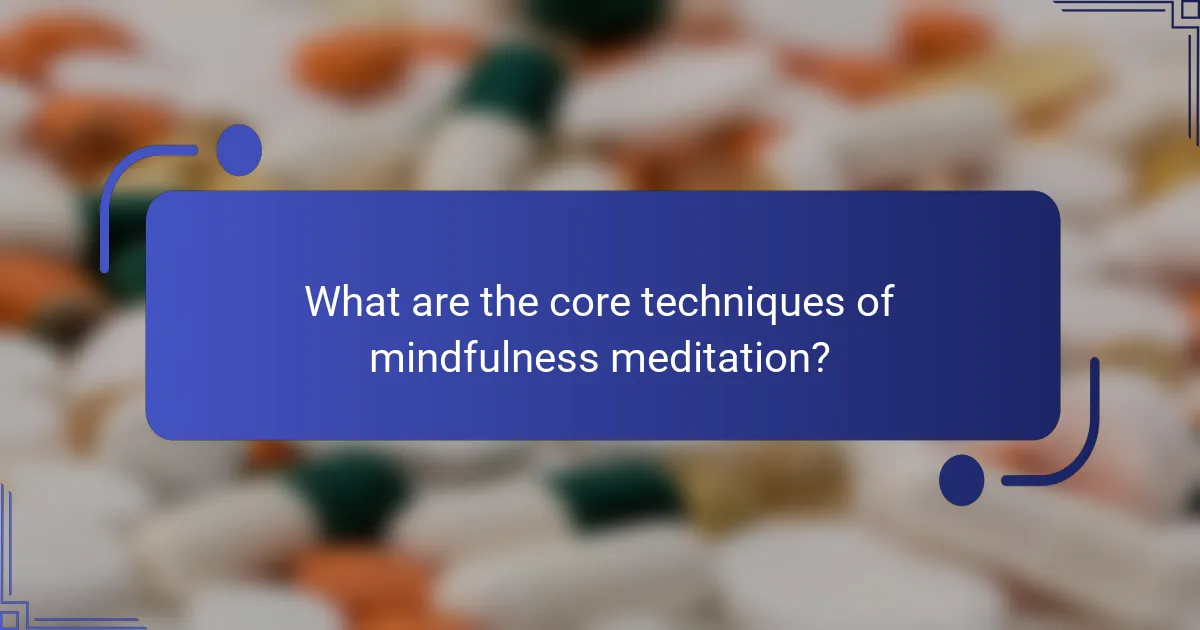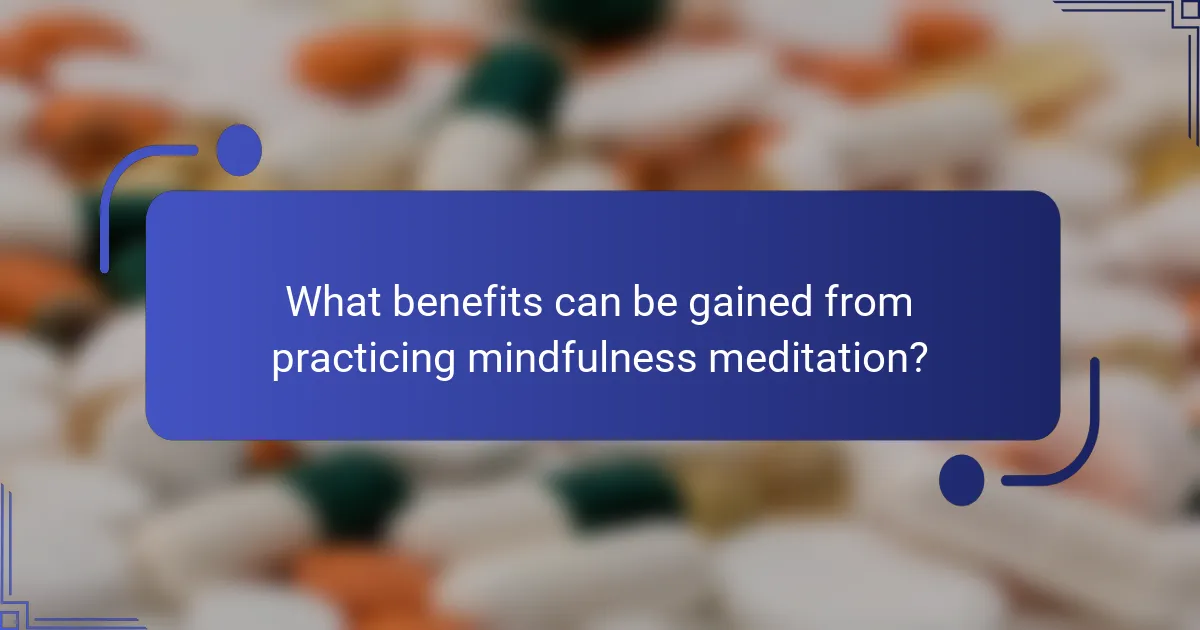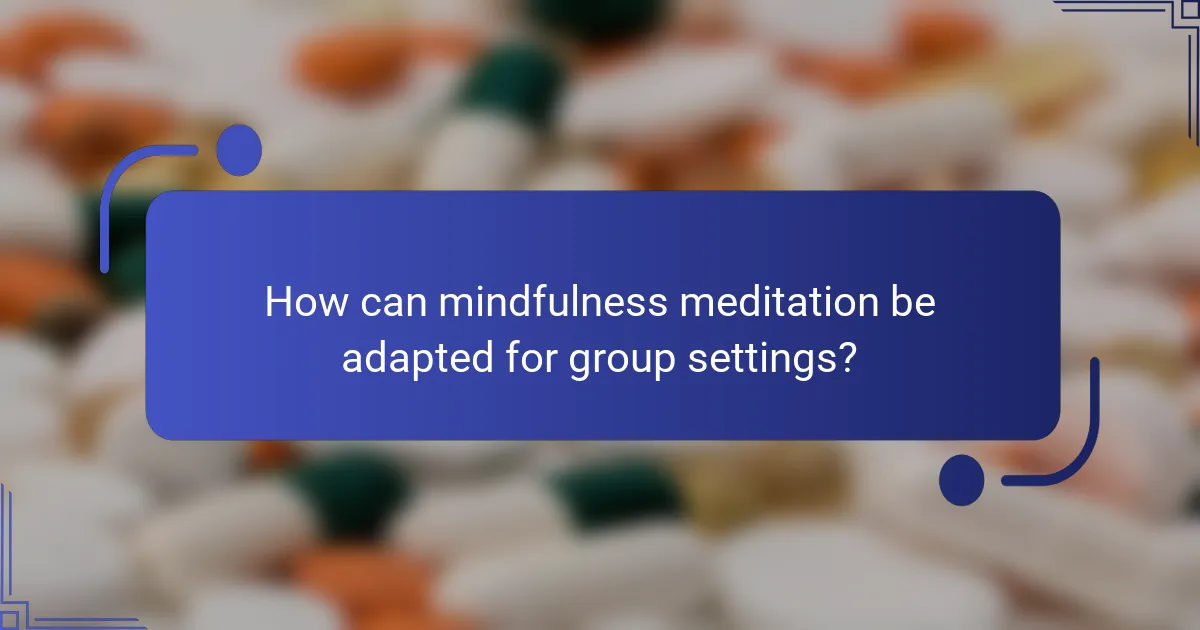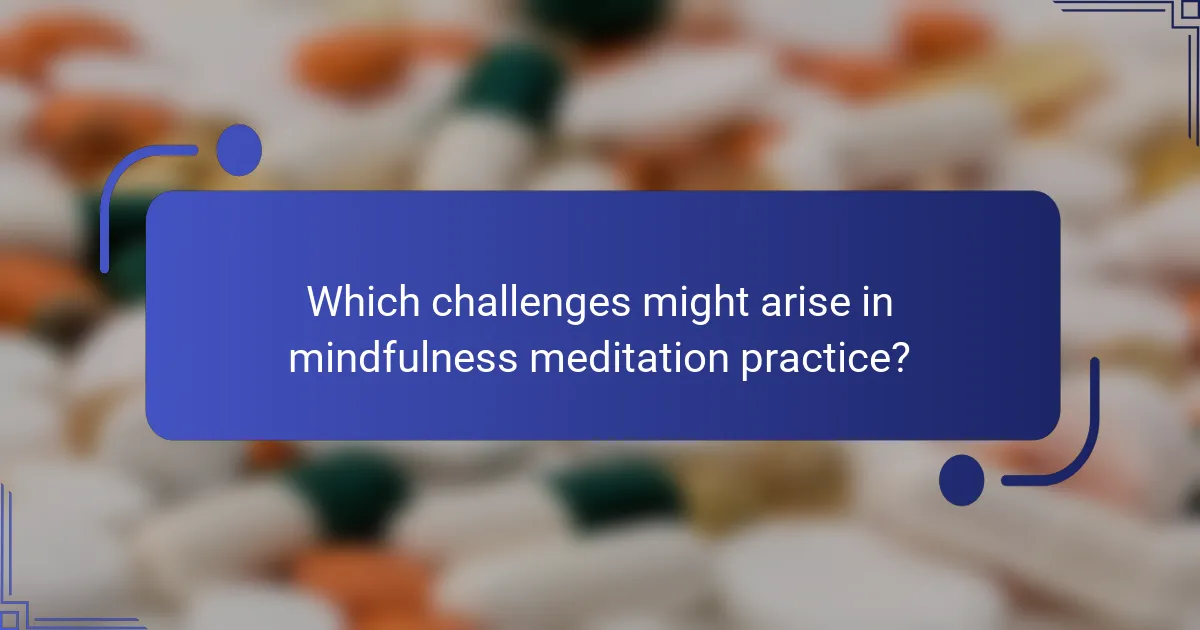Mindfulness meditation reduces stress and enhances emotional well-being. This article explores various techniques like focused attention, body scan, and mindful breathing. It highlights the benefits of regular practice, effective group settings, and challenges faced by practitioners. Additionally, it discusses tools and cultural variations that enrich the mindfulness experience.

What are the core techniques of mindfulness meditation?
Mindfulness meditation techniques include focused attention, body scan, and mindful breathing. These practices enhance awareness and promote relaxation. Focused attention involves concentrating on a single object or thought, while the body scan encourages awareness of physical sensations. Mindful breathing emphasizes observing the breath to anchor attention in the present moment. Each technique cultivates mindfulness, reducing stress and improving emotional regulation.
How can breath awareness enhance mindfulness practice?
Breath awareness significantly enhances mindfulness practice by anchoring attention in the present moment. This technique fosters greater concentration and emotional regulation. Practicing breath awareness can lead to reduced stress and improved mental clarity. Regular application strengthens the mind-body connection, promoting overall well-being.
What role does body scanning play in mindfulness meditation?
Body scanning enhances mindfulness meditation by fostering awareness of bodily sensations. This technique encourages practitioners to focus attention on different body parts, promoting relaxation and reducing stress. As a result, it cultivates a deeper connection between mind and body, improving overall mindfulness. Regular practice can lead to increased emotional regulation and heightened self-awareness.
Which visualization techniques are effective in mindfulness meditation?
Visualization techniques effective in mindfulness meditation include guided imagery, body scanning, and mindful breathing. These techniques enhance focus, promote relaxation, and deepen awareness. Guided imagery helps in creating mental pictures for calming the mind. Body scanning encourages awareness of physical sensations, while mindful breathing centers attention on the breath, fostering presence.

What benefits can be gained from practicing mindfulness meditation?
Practicing mindfulness meditation offers numerous benefits, including reduced stress, improved focus, and enhanced emotional well-being. Regular practice can lead to lower anxiety levels and better sleep quality. Research indicates that mindfulness meditation can change brain structure, increasing gray matter in regions associated with memory and emotional regulation. Additionally, it fosters greater self-awareness and compassion, contributing to healthier relationships.
How does mindfulness meditation reduce stress and anxiety?
Mindfulness meditation effectively reduces stress and anxiety by promoting relaxation and enhancing emotional regulation. This practice encourages awareness of the present moment, which helps individuals detach from stressors. Studies show that consistent mindfulness meditation can lower cortisol levels, a key stress hormone. Additionally, it fosters a greater sense of control over thoughts and emotions, leading to improved mental health outcomes. Regular practitioners often report heightened resilience and reduced anxiety symptoms, making mindfulness meditation a valuable tool for stress management.
What are the long-term mental health benefits of mindfulness meditation?
Mindfulness meditation offers significant long-term mental health benefits, including reduced anxiety, improved emotional regulation, and enhanced focus. Regular practice fosters resilience against stress and promotes a greater sense of well-being. Research indicates that mindfulness can lead to structural changes in the brain, enhancing areas related to attention and emotional processing. Additionally, it encourages self-awareness and acceptance, contributing to lower levels of depression and increased life satisfaction.
Which physical health improvements are associated with regular mindfulness practice?
Regular mindfulness practice leads to significant physical health improvements, including reduced stress levels, lower blood pressure, and enhanced immune function. Research indicates that mindfulness can decrease inflammation and improve cardiovascular health. Additionally, consistent practice promotes better sleep quality and aids in pain management. These benefits contribute to overall well-being and longevity.

How can mindfulness meditation be adapted for group settings?
Mindfulness meditation can be effectively adapted for group settings by incorporating shared experiences and collective focus. Group mindfulness fosters a sense of community, enhances motivation, and deepens individual practice through shared intention.
Techniques include guided sessions led by an instructor, where participants engage in collective breathing exercises and visualization practices. Incorporating discussions about personal experiences can enhance connection and understanding among group members.
Creating a structured environment with designated times for practice, reflection, and feedback can also enhance the effectiveness of group mindfulness sessions. This structure promotes accountability and encourages consistent participation.
Finally, utilizing a variety of formats, such as seated practices, walking meditations, or outdoor sessions, can cater to diverse preferences and keep participants engaged.
What are the unique dynamics of group mindfulness meditation sessions?
Group mindfulness meditation sessions foster a unique dynamic that enhances collective awareness and support. Participants share a space that amplifies individual experiences, creating a sense of community. The group energy can deepen relaxation and focus, leading to heightened mindfulness. Additionally, shared practices may introduce diverse techniques, enriching personal meditation journeys. Group sessions often include guided meditations, promoting a structured approach that benefits both beginners and experienced practitioners.
How can community support enhance individual mindfulness practices?
Community support significantly enhances individual mindfulness practices by fostering connection and accountability. Engaging with others creates a shared space for exploration and growth. Group practices, such as meditation sessions, provide motivation and diverse perspectives, enriching personal experiences. Additionally, community feedback can deepen understanding and reinforce commitment to mindfulness routines. Overall, collective engagement nurtures a supportive environment that amplifies the benefits of mindfulness meditation.

Which challenges might arise in mindfulness meditation practice?
Mindfulness meditation practice can face several challenges, including distractions, difficulty maintaining focus, and emotional discomfort. Participants may struggle with racing thoughts, physical restlessness, or impatience during sessions. Additionally, inconsistent practice can hinder progress, making it hard to experience the full benefits of mindfulness. Addressing these challenges often requires patience and commitment.
What common misconceptions exist about mindfulness meditation?
Many misconceptions about mindfulness meditation include the belief that it requires emptying the mind or that it is only for relaxation. In reality, mindfulness meditation focuses on awareness of thoughts and feelings without judgment. It can enhance mental clarity and emotional regulation, making it beneficial for various aspects of life. Another misconception is that mindfulness meditation is a quick fix; consistent practice is essential for lasting benefits. Some also think it is solely an individual practice, but group practices can enhance motivation and provide community support.
How can distractions be managed during meditation?
Distractions during meditation can be managed through focused techniques. First, establish a dedicated meditation space to minimize external interruptions. Next, practice mindfulness by acknowledging distractions without judgment, allowing thoughts to pass. Incorporate breath awareness to anchor your focus, redirecting attention when distractions arise. Regular practice builds resilience against distractions, enhancing overall meditation benefits.

What tools and resources are available for mindfulness meditation?
Various tools and resources enhance mindfulness meditation practice. Apps like Headspace and Calm provide guided sessions. Books such as “The Miracle of Mindfulness” offer insights and techniques. Online platforms host virtual classes and community forums. Local centers often conduct group meditation sessions.
Which apps are popular for guided mindfulness meditation?
Popular apps for guided mindfulness meditation include Headspace, Calm, Insight Timer, and 10% Happier. These platforms offer various features like personalized meditation sessions, sleep aids, and expert-led courses. Headspace is known for its user-friendly interface and structured programs. Calm excels in sleep meditation and soothing sounds. Insight Timer provides a vast library of free guided meditations. 10% Happier focuses on practical mindfulness techniques for skeptics. Each app caters to different user preferences and meditation goals.
What literature offers insights into advanced mindfulness techniques?
Literature on advanced mindfulness techniques includes works by Jon Kabat-Zinn, Thich Nhat Hanh, and Tara Brach. These authors explore various practices that deepen mindfulness meditation. For instance, Kabat-Zinn’s “Wherever You Go, There You Are” emphasizes present-moment awareness. Thich Nhat Hanh’s “The Miracle of Mindfulness” offers insights into mindful living. Tara Brach’s “Radical Acceptance” integrates mindfulness with self-compassion. These resources provide valuable techniques for enhancing mindfulness practices.

How does mindfulness meditation vary across different cultures?
Mindfulness meditation varies across cultures in techniques, practices, and underlying philosophies. In Buddhism, it emphasizes awareness and compassion, often through breath-focused meditation. In Western contexts, mindfulness often integrates cognitive behavioral approaches, focusing on stress reduction and emotional regulation. Indigenous practices may incorporate nature and community, highlighting the connection between mindfulness and cultural identity. Each variation reflects unique cultural values and goals, shaping the overall experience of mindfulness meditation.
What are the distinctive practices in mindfulness meditation in Eastern traditions?
Distinctive practices in mindfulness meditation within Eastern traditions include techniques such as breath awareness, body scanning, and loving-kindness meditation. These practices emphasize present-moment awareness and compassion, fostering mental clarity and emotional resilience. Techniques often integrate traditional beliefs, enhancing spiritual growth and self-awareness. Unique attributes include the incorporation of mantra repetition in some practices, which aids concentration and deepens meditation. Group practices, such as sitting in silence together or engaging in guided meditations, strengthen community bonds and collective mindfulness experiences.
How is mindfulness meditation perceived in Western psychology?
Mindfulness meditation is increasingly embraced in Western psychology as a therapeutic tool. It enhances emotional regulation, reduces stress, and improves overall well-being. Research shows mindfulness can lead to significant reductions in anxiety and depression symptoms. Its integration into clinical practices reflects a growing recognition of its benefits, supported by studies demonstrating its effectiveness in various psychological conditions.
Which rare mindfulness practices are gaining attention in modern contexts?
Rare mindfulness practices gaining attention include forest bathing, sound meditation, and breathwork. These techniques enhance mental clarity and emotional well-being.
Forest bathing, or Shinrin-yoku, immerses individuals in nature, promoting relaxation and reducing stress. Sound meditation utilizes sound vibrations to facilitate deeper states of awareness. Breathwork focuses on controlled breathing techniques to enhance emotional release and physical health.
These practices reflect a growing interest in diverse mindfulness techniques, appealing to those seeking innovative approaches to mental wellness.
What expert tips can enhance your mindfulness meditation experience?
To enhance your mindfulness meditation experience, focus on consistency, environment, and breath awareness. Establish a regular practice schedule to build habits. Choose a quiet, comfortable space free from distractions to foster relaxation. Concentrate on your breath, noticing its rhythm and sensations to anchor your attention effectively.


